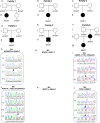Genetic aetiologies for childhood speech disorder: novel pathways co-expressed during brain development
- PMID: 36117209
- PMCID: PMC10208970
- DOI: 10.1038/s41380-022-01764-8
Genetic aetiologies for childhood speech disorder: novel pathways co-expressed during brain development
Erratum in
-
Correction: Genetic aetiologies for childhood speech disorder: novel pathways co-expressed during brain development.Mol Psychiatry. 2023 Apr;28(4):1664-1666. doi: 10.1038/s41380-022-01879-y. Mol Psychiatry. 2023. PMID: 36658335 Free PMC article. No abstract available.
Abstract
Childhood apraxia of speech (CAS), the prototypic severe childhood speech disorder, is characterized by motor programming and planning deficits. Genetic factors make substantive contributions to CAS aetiology, with a monogenic pathogenic variant identified in a third of cases, implicating around 20 single genes to date. Here we aimed to identify molecular causation in 70 unrelated probands ascertained with CAS. We performed trio genome sequencing. Our bioinformatic analysis examined single nucleotide, indel, copy number, structural and short tandem repeat variants. We prioritised appropriate variants arising de novo or inherited that were expected to be damaging based on in silico predictions. We identified high confidence variants in 18/70 (26%) probands, almost doubling the current number of candidate genes for CAS. Three of the 18 variants affected SETBP1, SETD1A and DDX3X, thus confirming their roles in CAS, while the remaining 15 occurred in genes not previously associated with this disorder. Fifteen variants arose de novo and three were inherited. We provide further novel insights into the biology of child speech disorder, highlighting the roles of chromatin organization and gene regulation in CAS, and confirm that genes involved in CAS are co-expressed during brain development. Our findings confirm a diagnostic yield comparable to, or even higher, than other neurodevelopmental disorders with substantial de novo variant burden. Data also support the increasingly recognised overlaps between genes conferring risk for a range of neurodevelopmental disorders. Understanding the aetiological basis of CAS is critical to end the diagnostic odyssey and ensure affected individuals are poised for precision medicine trials.
© 2022. The Author(s).
Conflict of interest statement
The authors declare no competing interests.
Figures







References
-
- American Speech-Language-Hearing A. Childhood apraxia of speech [Technical report]. 2007.
Publication types
MeSH terms
Substances
LinkOut - more resources
Full Text Sources
Medical

